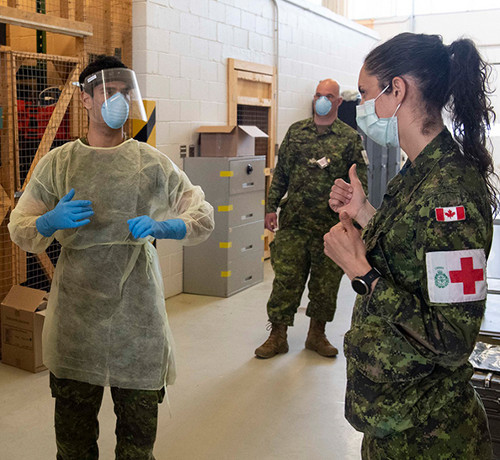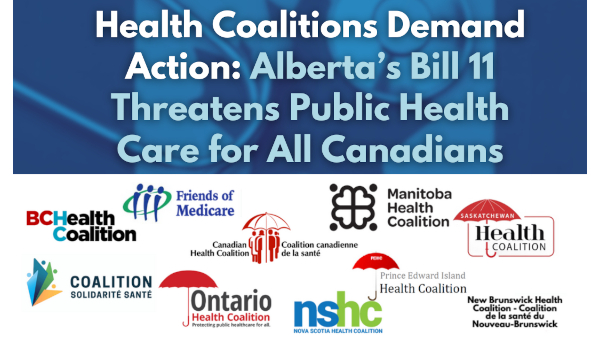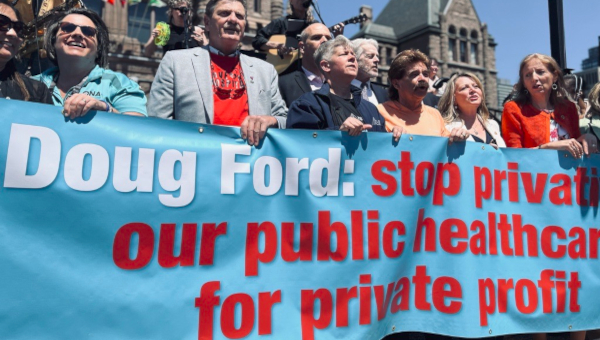COVID-19 and the Crisis in Long-Term Care in Ontario
The Ontario Health Coalition sent an open letter to Ontario Premier Doug Ford signed by family councils, health professionals, social organizations, cultural organizations, seniors’ and retirees’ groups, health coalitions, legal clinics, and many others who collectively represent more than 1.5 million Ontarians. Almost unbelievably, the Ford government is rushing through their new home and community care law through the provincial legislature, Bill 175 Connecting People to Home and Community Care Act 2020, during the pandemic, after being hustled through first and second readings in early March. A Ontario Health Coalition Briefing Note on the Bill, Ford Government’s Home Care Changes Dismantle Public Control, Risks Privatization, follows the Open Letter.
Dear Premier Ford,
While we are pleased that your government has committed to independence, non-partisanship and transparency with regards to the commission into long-term care and COVID-19, we are seeking some assurances regarding both this commission and the immediate measures needed that cannot wait for a commission. In addition, we believe that it is imperative that Ontario hold a full public commission or inquiry into the province’s overall response to COVID-19, like the SARS Commission, as there are many lessons to be learned from this experience beyond the long-term care sector.

To be clear, the Ontario Health Coalition called for the commission into long-term care to be under the Public Inquiry Act. You have voted against this in the Legislature. Failing that, Premier, we must state in the clearest possible terms that it will be unacceptable to the public if the commissioner(s) and any supporting staff are not fully independent of long-term care operators. Any long-term care commission must have unimpeachable credibility and operate in the public interest. This means it cannot be led or controlled by any partisan (political party) interests or by long-term care owners and operators. It must be transparent and open, not by invitation only. Access to the Commission must be equitable and it must allow for voices from families, residents, staff and their associations and unions, public interest groups and advocates who have worked closely on these issues. Care workers and professionals must be protected to speak on the record about conditions in the homes. Testimony and research must be on the record and fully available publicly as with formal commissions and inquiries in the past, and the commission must report as quickly as possible.
Further, this commission cannot delay immediate action being taken to stabilize and support the workforce to stop the COVID-19 outbreaks that continue to spread in long-term care homes across significant parts of Ontario. We need a coherent plan from your government to stop the spread of COVID-19 in long-term care and retirement homes, including concrete measures to improve PPE supply, workplace safety and infection control, and to stabilize the workforce. We urgently need your government to take leadership and concrete coordination measures to immediately address critical staffing shortages that mean even basic daily care like feeding, bathing, hygiene, human contact are not able to be done; that palliative care needs are not being met; that care for the gravely ill is less than what is needed, as follows:
- Understaffing in long-term care is critical and must be addressed. The provincial government cannot rely on long-term care homes in crisis to get themselves out of crisis. There must be a coherent plan, led by our government, to step in with a set of coordinated, concrete measures to get staff into the homes that have lost staffing levels due to sickness, having to choose one part-time job, staff leaving etc. Leaving it to the providers to forge voluntary arrangements among themselves is not sufficient. Staff need a permanent improvement to their wages and access to full-time hours. This cannot be voluntary and there is no path to stability without the provincial government undertaking these measures. In addition to the permanent improvements to wages and access to full-time work, measures are needed while homes’ operations remain under the emergency directives. Many staff have lost significant hours of work (and thus income) as a result of the requirement to choose one work site. They are risking their health and their families to go into the homes to do care work and the loss of hours is not offset by the pandemic pay increase. Yet some homes are bringing in PSW aides, nurses and others without giving their part-time staff any increase in hours. To address this, long-term care homes must be required to increase their pay for part-timers who have been required to give up part-time work in other homes to be equivalent to full-time pay and benefits, so as not to maintain the operator’s economic incentive to limit the proportion of care delivered by full time staff. Further, the Minister of Long-Term Care must use her powers to revoke licences and appoint new management in long-term care homes that have uncontrolled outbreaks and evidence of negligence and poor practices.
- Infection control practices, workplace safety and access to PPE must be improved. Reusing surgical masks patient after patient, resident after resident, would have been totally unacceptable before COVID-19. Insufficient access to N95 masks continues to be a problem and there are shortages of other equipment. There needs to be a clear plan from the government to improve the supply of PPE or develop our own. Leaving it to industry to do voluntarily has so far been insufficient. Standards for infection control and workplace safety must be improved. Staff need the appropriate equipment, enough supply and training in order to comply with them. Staff who are infected must be supported to isolate at home. The directive allowing health care facilities to require staff to work who have tested positive for COVID-19 but are asymptomatic is dangerous and should be changed as should the loopholes that fail to stop agency staff from working at more than one location. Ongoing training and support for infection control regarding the use of PPE are needed. Testing of all residents and staff must be ongoing in long-term care homes, and completed in retirement homes and congregate care facilities (and shelters). Testing, tracking and isolating people who test positive is shown to have stopped the spread of COVID-19 in other countries. It must happen here. Access to PPE using the precautionary principle must be implemented in long-term care, hospitals, home care and across the health care system as soon as possible.
- Testing, contact tracing and isolation must be improved using our province’s full public capacity. Public hospital laboratories that are not currently doing COVID-19 testing and have unused capacity should be ramping up testing. We need a clear honest plan from the provincial government that assesses our full capacity to test (including all the public hospitals, not just those that are currently testing) and immediately ramp up to our province’s real full capacity the testing, tracking and isolating to stop the spread of COVID-19. There must be a coherent plan and immediate action to get the supply or develop it for testing kits, swabs and reagents, and transparency about what is happening with this.
- Transfers to hospitals. Where there are long-term care homes in crisis without sufficient staff to provide proper palliative and end-of-life care, as well as being unable to address the general care requirements of the residents, residents should be considered for transfer to public hospitals, which are not in crisis, for safe and proper care, subject to their right to consent.
- Bring in family caregivers and volunteer nurses as soon as possible: As soon as testing/contact tracing capacity and PPE supply are stabilized enough to do so, and as soon as training in infection control can be properly conducted, primary family caregivers need to be able to be involved as partners in their families’ care. The pool of nurses that the RNAO has recruited to help should be utilized if they have not already been.
- Institute a minimum care standard in long-term care. There has been deep consensus for decades that the rising acuity (complexity and severity of the care needs) of long-term care residents requires more care. This cannot be left to operators to do on their own, and resources – both financial and human – need to be provided to support this. There cannot be further delay in beginning to move to a 4-hour average minimum care level for residents in long-term care to protect their safety and the safety of staff.
Premier, we are also deeply concerned about our research finding that the death rates in for-profit homes are significantly higher than in non-profit homes. It is imperative that your government halt any expansion of for-profit long-term care. We will follow up with your office regarding these issues and look forward to your response. •
Cordially,
Natalie MehraRoss Sutherland
Executive Director Chairperson
Click here for complete list of more than 100 organizations representing more than 1,500,000 Ontarians that have signed onto this letter.
The Ford Government’s Planned Changes to Home and Community Care
Ontario’s home care system provides care to more than 730,000 Ontarians. The Ford government has introduced home care legislation that dismantles all remaining public governance and provision of home care services. It would turn over the control of home care to an array of provider companies and organizations to contract, subcontract, and provide in an array of different structures created by the provider companies themselves. In their plan, the legislation regarding home care is repealed and not replaced. Instead, the proposal moves most of the key elements of home care governance out of legislation and into regulation which can be changed at any time without going back to the Legislature and without any meaningful public input. The process by which these dramatic changes are being made is rushed and undemocratic. This briefing note provides a summary of the major changes and our key concerns.

Deregulation and Dismantling of Public Home Care Governance
The new regime set out for home and community care dismantles most if not all public governance of home care. All remaining publicly owned and controlled home care would be transferred to an array of provider organizations including for-profit and non-profit organizations. The legislation is permissive, repealing the previous Home Care and Community Services Act and enabling the provider organizations to structure, contract, subcontract and run home care in an array of different ways that they would develop themselves. A significant proportion of the organizations that would take over previously publicly controlled home care functions either have no governance and public accountability structure (as in the Ontario Health Teams which are loose coalitions including for- and non-profits that self-govern with no public meetings, no access to information, no elected boards of directors, etc.) or are private (as in private for-profit home care companies) or are non-profit, of which some are actually community-based and democratic.
Summary of the changes under the proposed legislation and regulation:
1. The Ford government’s Super Agency called Ontario Health would take over funding home and community care services from the Local Health Integration Networks (LHINs). The Super Agency (Ontario Health) is governed by a Board that is not subject to the Ontario public service legislation regarding conflict of interest and includes an array of pro-privatization business people, bankers and corporate executives, has no regulations for public input, open board meetings, public access to information and even less democratic protections than the LHINs.
2. The power to contract home care services (and apparently placement coordination functions) currently held by the LHINs would be handed off to an array of different organizations that are not publicly governed and accountable. These can include non-profit agencies, the Ontario Health Teams (which are loose coalitions without any public governance structures that include for-profit and non-profit companies) and primary care providers (most of which do not have public governance and accountability structures). The LHINs, which we advocated to be reformed to make them more public and accountable not less, are Crown Agencies, set up as public entities and operated on a non-profit basis.
3. The care coordination functions of the LHINs would be contracted by these organizations to provider home care companies (majority for-profit) or to unnamed third parties.
4. The LHINs will be renamed and continued on an “interim” basis until home care is transferred on a phased and gradual basis to the Ontario Health Teams or Health Service Providers.
Privatization of Public Home Care Governance and Services
This change means that significant and vital parts of home care could be privatized, including transfer of control from publicly-controlled LHINs to the Ontario Health Teams which are loose coalitions that include for-profit companies, and transfer of care coordination functions to an array of provider companies that are dominated by for-profit chains. This proposal would enable for-profit corporations to both coordinate care and be the providers of that care. This means that they themselves determine how many visits a person can have, how many supplies and resources are allotted to them, and supervise their own care. Already missed visits and non-fulfillment of contracts is a major longstanding problem for home care clients, compromising their care and safety. This is a conflict of interest and it is not in the public interest.
The proposal includes the creation of a new tier of unlicensed residential services without any public interest protections, and no protections against downloading and erosion of existing protections in hospital and long-term care. If this proposal were to expand the provision of supportive housing and was clearly defined as this, it would be welcome. Of concern is that instead of increasing care levels for our elders and vulnerable people, this tier would actually lower them. Among the changes, also, is a provision to send privatized home care into public hospitals. In addition, the proposal includes provision for the expansion of private for-profit hospitals into these and other residential care services (including potentially services that are provided by public hospitals and by long-term care homes). It is not in the public interest to expand private for-profit hospitals.
Inequities, Fragmentation and Chaotic Restructuring
This plan is chaotic. It would mean that home care will be governed by different entities in different regions according to different models. The plan would enable this array of different providers to structure and contract home care themselves. The Ontario Health Teams have no governance provisions. Not all of Ontario is covered by them. They are all different and it is uncertain how they will work. The first set are just getting started. This model does not “integrate” home care. It dismantles all existing public governance and devolves it to an array of service providers with very different cultures, motives, capacities, and governance models (or no governance model).
No Improvements to Access, Costs, Assessments, Missed Visits etc.
The proposal removes a host of existing public interest protections under the Home Care and Community Services Act and does not improve on existing provisions regarding access and eligibility, out-of-pocket costs, expansion of virtual home care without patient protections, and others. There is nothing in the new plan that provides any better protections for home care clients regarding access to care, assessments that do not measure actual need, rationing of home care, inequities from region to region, missed visits and other major problems in home care. •





